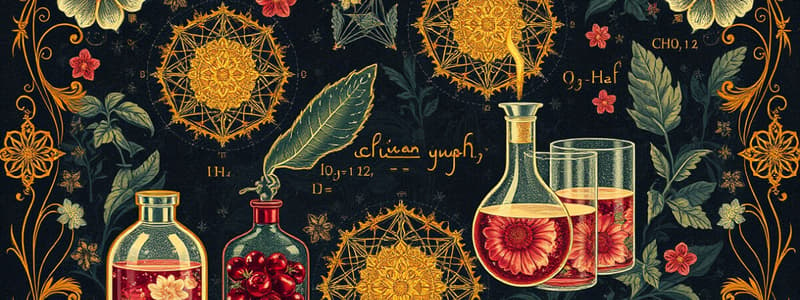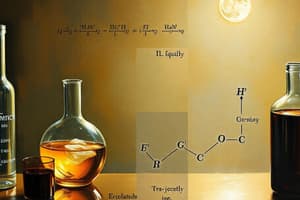Podcast
Questions and Answers
Which of the following are evidence for a chemical reaction? (Select all that apply)
Which of the following are evidence for a chemical reaction? (Select all that apply)
- Color change (correct)
- Temperature stays constant
- Solid forms (correct)
- Bubbles form (correct)
What is a chemical reaction?
What is a chemical reaction?
A chemical change that involves a rearrangement of the ways in which atoms are grouped.
What does a chemical equation represent?
What does a chemical equation represent?
How you represent a chemical reaction with reactants on the left and products on the right.
What are reactants?
What are reactants?
What are products?
What are products?
Making sure the equation for a reaction obeys the law of conservation of matter is called ____________.
Making sure the equation for a reaction obeys the law of conservation of matter is called ____________.
Match the physical states indicated in equations with their symbols:
Match the physical states indicated in equations with their symbols:
Atoms are neither ____________ nor ____________, they are just ____________ ____________.
Atoms are neither ____________ nor ____________, they are just ____________ ____________.
What are the steps to write and balance chemical equations?
What are the steps to write and balance chemical equations?
What is the smallest particle of a molecular compound or a diatomic element?
What is the smallest particle of a molecular compound or a diatomic element?
What is the smallest particle of an ionic compound referred to as?
What is the smallest particle of an ionic compound referred to as?
Flashcards are hidden until you start studying
Study Notes
Evidence of a Chemical Reaction
- Signs include color change, formation of solid (precipitate), gas bubbles, heat or flames produced, and heat absorption.
Chemical Reaction
- Represents a chemical change involving the rearrangement of atom groupings.
Chemical Equation
- A representation of a chemical reaction with reactants on the left and products on the right of an arrow.
Reactants
- The substances that are present before a chemical reaction occurs.
Products
- The substances that are formed as a result of a chemical reaction.
Balancing Chemical Equations
- Ensures compliance with the law of conservation of matter by balancing the number of atoms on both sides of the equation.
Physical States in Equations
- Various physical states are indicated with symbols:
- (s) for solid
- (l) for liquid
- (g) for gas
- (aq) for aqueous solution (dissolved in water)
Conservation of Atoms
- Atoms are neither created nor destroyed; they are simply rearranged in different configurations during reactions.
Writing and Balancing Chemical Equations
- Steps to write and balance:
- Read the chemical reaction description to identify reactants, products, and their states; write corresponding formulas.
- Write an unbalanced equation summarizing the noted information.
- Balance the equation using trial and error, starting with the most complex molecule.
- Verify that the coefficients used reflect an equal number of each type of atom on both sides.
Molecular and Ionic Compounds
- The smallest particle of a molecular compound or diatomic element is identified as a molecule.
- The smallest particle of an ionic compound is referred to as a formula unit.
Studying That Suits You
Use AI to generate personalized quizzes and flashcards to suit your learning preferences.




